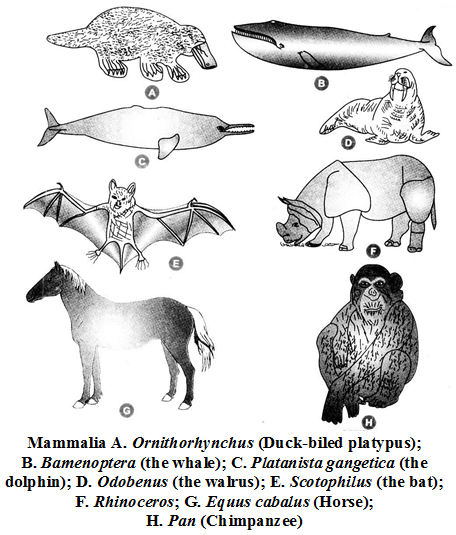What are the Characteristics of the Kingdom Animalia
Kingdom : Animalia or Animal Kingdom
- These organisms are multicellular, eukaryotic and without chlorophyll.
- The cells possess no cell walls and plastids.
- Central vacuoles are absent but small vacuoles may occur.
- Most of them are free moving (except sponges and some coelentrates)
- Nutrition is primarily ingestive.
- Reproduction is generally sexual and the haploid stage is represented only by gametes.
- Growth of organisms stops when the adult stage is reached.
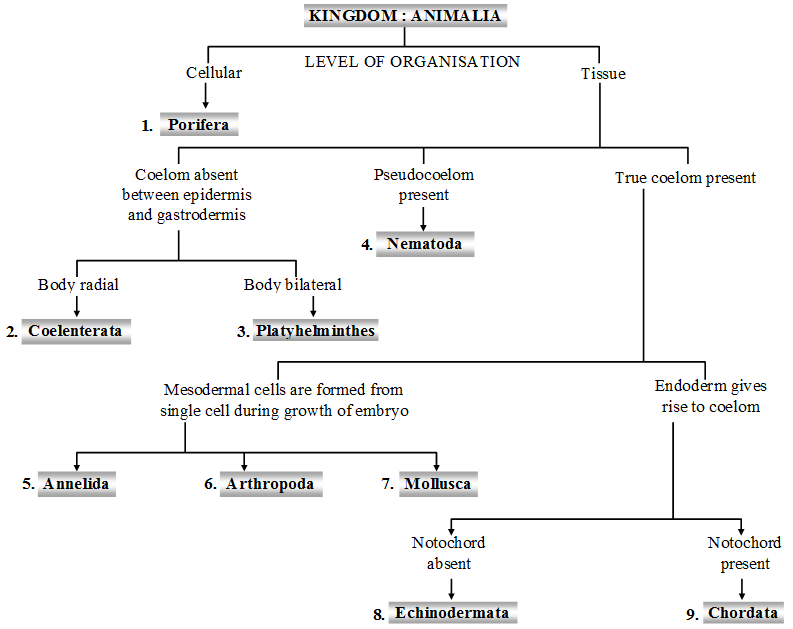 Phylum – Porifera :
Phylum – Porifera :
- Sessile (stalk-less) and marine except one group that lives in fresh water.
- Simplest multicellular, diploblastic animals.
- Have organisation at cellular colony level. Thus, cells are loosely held together and do not form tissues.
- Asymmetrical or radially symmetrical. Sponges may be vase-like, rounded, sac-like branched.
- Body is perforated by numerous pores, the ostia that open into a canal system having canals and chambers lined with collared flagellated cells or choanocytes.
- Examples – Sycon, Euplectella, (Venus flower basket) Spongilla (Fresh water sponge).
 Phylum – Cnidaria (Coelenterata) :
Phylum – Cnidaria (Coelenterata) :
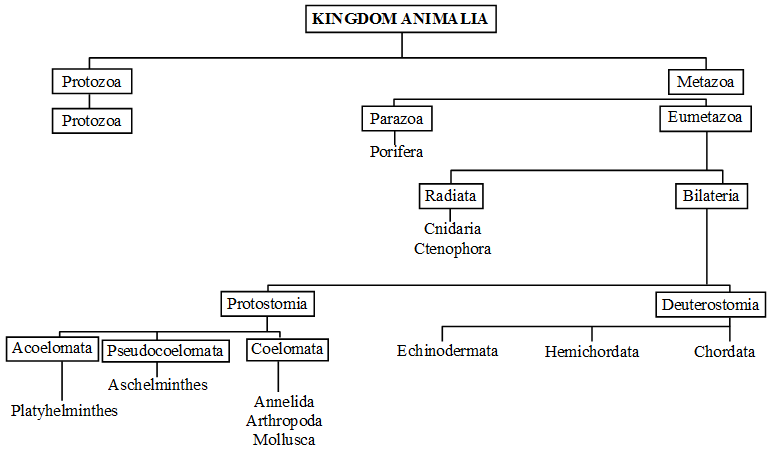
- Aquatic, mostly marine, a few such as Hydra are fresh water solitary or colonial forms.
- Body shows radial symmetry.
- Possese specialized cells (cnidoblasts) bearing stinging organoids called nematocysts. Nematocysts serve the functions of paralysing the prey by injecting poison or to hold the prey.
- Exhibit the phenomenon of polymorphism
(Ex- Physalia). - Body shows two main forms, the polyps and the medusae.
- Examples – Hydra, Obelia (sea fur) , Aurelia(jelly fish), Metridium (sea anemone).
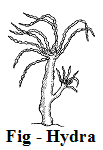 Phylum – Platyhelminthes :
Phylum – Platyhelminthes :
- Bilaterally symmetrical and dorsoventrally flattended animals.
- Body thin, soft, leaf-like or ribbon-like.
- Digestive cavity (when present) with a single opening, the mouth (anus is absent).
- Suckers and hooks are usually present.
- Circulatory and respiratory system and skeleton are absent.
- Excretory system consists of blind tubules called protonephridia.
- Examples : Dugesia (Planaria), Fasciola (liver fluke), Schistosoma (Blood fluke), Taenia solium (Pork Tape worm).
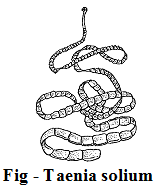 Phylum – Aschelminthes or nematoda
Phylum – Aschelminthes or nematoda
- They are parasitic or free-living.
- They are triploblastic, unsegmented and show bilateral symmetry.
- Body cavity is not a true coelom.
- Alimentary canal is complete.
- Sexes are separate.
- Examples : Ascaris (Round worm), Enterobius (Pin worm), Wuchereria (filaria worm)
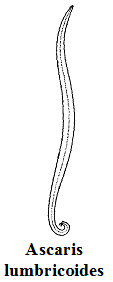 Phylum – Annelida :
Phylum – Annelida :
- They occur in moist soil, fresh water and sea.
- They are elongated, with segmented body and bilateral symmetry.
- First animals with true body cavity (coelom).
- Body bears lateral appendages for locomotion in the form of chitinous setae or parapodia.
- Examples : Nereis (sand worm) Aphrodite (sea mouse), Pheretima (earthworm), Hirudinaria (Cattle leech)
 Phylum – Arthropoda :
Phylum – Arthropoda :
- Body is covered with a thick chitinous covering.
- Respiration through general body surface, by gills, air tubes (tracheae) or book-lungs.
- Body segments are grouped into two regions-cephalothorax (head and thorax together and abdomen, or three regions-head, thorax and abdomen.
- Triploblastic, bilaterally symmetrical and metamerically segmented animals.
- Each body segment usually bears paired lateral and jointed legs or appendages.
- Example : Palemon (Prawn), Daphnia (water flea), Limulus (King crab), Palamnaeus (Scorpion)
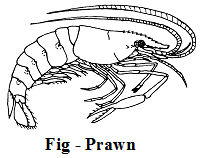 Phylum – Mollusca :
Phylum – Mollusca :
- They have soft, unsegmented body.
- Body is divided into three regions (head visceral mass and ventral foot).
- Outer surface is covered by a hard calcareous shell.
- Respiration is by gills called ctenidia.
- The sexes are usually separate.
- Examples : Chiton, Pila (Snail), Unio (Fresh water mussel), Octopus (Devil fish).
 Phylum – Echinodermata :
Phylum – Echinodermata :
- They are marine, gregarious (live in groups) and free-living animals.
- Shape may be star-like, spherical or elongate.
- Body surface is covered all over by calcareous spines.
- Aristotle’s lantern for mastication.
- Their symmetry is radial in adults but bilateral in larvae.
- Tube feet for locomotion.
- These are unsegmented.
- Body cavity is modified into a water-vascular system or ambulacral system with tube like outward extension for locomotion, called tube feet.
- Examples : Asterias (Star fish), Echinus (Sea urchin), Holothuria (Sea cucumber), Antedon (Feather star)
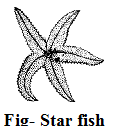 Phylum – Chordata
Phylum – Chordata
- Chordata are characterized by following basic features :
- A dorsal, hollow, tubular nerve cord.
- Notochord present.
- Gill slits in the pharynx.
- Tail behind the anal opening.
- Ventral heart.
 Sub-phylum : Protochordata
Sub-phylum : Protochordata
- The sub-phylum protochordata includes animals which are bilaterally symmetrical, unsegmented, tripolblastic and have a body cavity or coelom.
- The animals belonging to protochordata possess a notochord at some stage in the life history. This is flexible rod that lies between the dorsal nerve tube and the gut.
- The notochord provides a place for muscles to attach. It increases internal support and locomotory power.
- Protochordates are usually marine, soft, have worm-like or vase-like forms.
- Examples : Balanoglossus (a corn worm or tongue worm), Herdmania and Amphioxus, etc.
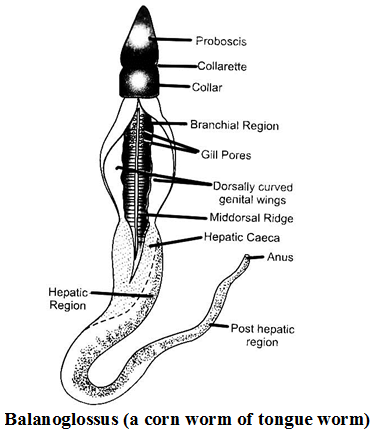 Sub-phylum : Vertebrata
Sub-phylum : Vertebrata
- The sub-phylum vertebrata includes animals which are bilaterally symmetrical, triploblastic, coelomic and segmented.
- The animal body typically consists of four regions : head, neck , trunk and tail.
- The notochord is replaced partly or fully by a jointed vertebral column (back bone) in the adult. The body of vertebrates is characterized by the presence of a well developed skeletal system that allows a special distribution of muscle attachment points to be used for movement.
- Besides vertebral column and internal skeleton the vertebrates have a well developed nervous system (brain) and sense organs (eyes, ears and nose).
- The vertebrates have a complex differentiation of body tissues or organs.
- There are two pairs of appendages (fins or limbs)
- Respiration is by gills in lower aquatic vertebrates. Higher land forms have lungs for gaseous exchange.
- Sexes are separate.
Subphylum Vertebrata is divided into seven classes :
- Class : Pisces
- Class : Amphibia
- Class : Reptilia
- Class : Aves
- Class : Mammalia
Pisces
- The animals belonging to class-Pisces are commonly called fishes. They exclusively live in water
- The skin of fishes is covered with scales/plates, which helps these animals to live in water
- The body may be long, laterally compressed and spindle shaped or dorsiventrally flattened and disc shped. It usually consists of head, trunk and a musclular tail.
- The muscular tail and fins help them to swim in water and move from one places to another.
- Fishes are cold-blooded animals and their hearts have only two chambers – one auricle and one ventricle.
- Fishes obtain oxygen dissolved in water and breathe through gills.
- They are egg laying animals. Fertilization is external.
There are many kinds of fishes. They have been broadly grouped under three categories.
- Cyclostoma : The round mouthed fishes. Examples, The hag fish, the lamprey.
- Chondrichthyes : The cartilaginous fishes. Examples Scoliodon (dog fish or the Indian Shark), sting ray, electric ray (Torpedo) (figure).
- Osteichthyes : The bony fishes. Examples, Labio rohita (Rohu), Hippocampus (Sea horse), Tuna, etc.

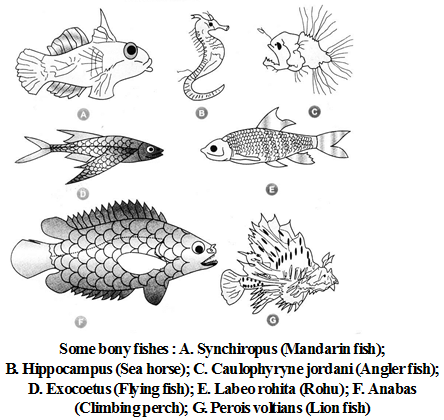 Class – Amphibia :
Class – Amphibia :
- In evolutionary terms, amphibians form the first group among the chordates to live out of water and to comprise first four-legged (tetrapod) land vertebrates. They live on land but lay their eggs in water. Amphibians are vertebrates leading two lives.
- These cold blooded animals live partly in fresh water and partly on land (moist places).
- Skin is smooth or rough, moist, slimy, glandular and mostly without scales.
- Heart 3 chambered.
- Body with distinct head and trunk, no neck.
- Two pairs of pentadactyl (five digit) limbs are present. Digits or toes without claws. Limbs may be absent in some cases.
- Example : Ichthyophis, Amphiuma (congo ell), Salamandra, Ambystoma, Necturus, Rana (bull frog), Bufo (toad), Hyla (tree-frog).
 Class – Reptilia :
Class – Reptilia :
- Cold-blooded, terrestrial or aquatic vertebrates with body covered with dry water-proof skin having horny scales or scute plates.
- Heart 3½ chambered. Crocodyles have 4 chambered heart.
- Body varies in form and is usually divided into head, neck, trunk and tail.
- Limbs tetrapodous pentadacytle (five-toed) type with clawed digits (limbs are absent snakes and some lizards).
- Tympanum small and depressed.
- Teeth are present in all reptiles except in tortoises and turtles.
- Example : Kachuga (roofed-terrapin), Testudo (land-tortoise), Uromastix (sand-lizard), Hemidactylus (wall lizard), Calotes (garden-lizard), Draco (flying-lizard) Chamaeleon, Cobra etc.
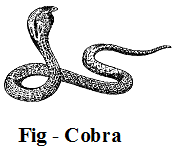 Class – Aves :
Class – Aves :
- Warm-blooded, tetrapodous vertebrates (birds) with various flight adaptations.
- Size ranges from smallest humming bird to largest ostrich.
- Heart 4 chambered.
- Horny scales persist on the feet but feathers cover most of the body. Cutaneous glands are absent.
- Boat-shaped body is divisible into head, neck, trunk and tail.
- Fore-limbs modified into wings for flight. Kiwis have vestigial wings.
- Example : Gallus (chicken), Passer (house sparrow), Corvus (crow), Columba (pigeon), Psittacula (parrot), Pavo (peafowl peacock), Eudynamys (koel), Bubo (owl)
 Class – Mammalia :
Class – Mammalia :
- Mammals are primarily terrestrial vertebrates. They occur in all sorts of habitats from the polar regions to the tropics.
- The body is variously shaped and generally divisble into head, neck, trunk and tail.
- The skin is glandular and mostly covered by a horny epidermal exoskeleton of hair.
- There are two pairs of pentadactyl limbs. These are variously adapted for various purposes.
- Respiration occurs only by lungs.
- The heart is four chambered, having two auricles and two ventricles.
- Sexs are usually distinguishable externally.
- Mammals are mostly viviparous (alive-bearing). However, some are oviparous and lay eggs (e.g., platypus and echidna. Kangaroos give brith to very poorly developed young ones). They are characterized by having milk-secreting mammary glands in the females for sucking the young for some time after birth.
- Examples : Macropus (Kangaroo), Bat, Ratuus (rat), Oryctolagus (rabit), Felis (cat), Panthera (lion, tiger, leopard), Canis (dog) Elephas (elephant), Balaena (whale), Macaca (monkey), Hamo (man), Pan (chimpanzee)
